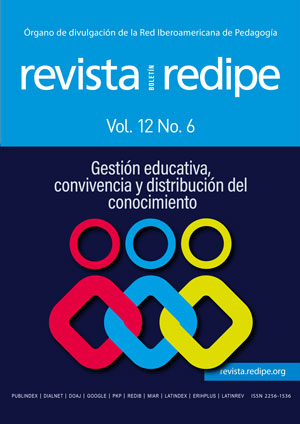Pedagogical strategies for healthy coexistence from the chair of peace
Main Article Content
Keywords
Teaching strategy, Pedagogy, Peaceful coexistence, Educational environment, Conflict resolution, Education for peace
Abstract
The present study consisted of designing pedagogical strategies for the Peace Chair subject, which strengthen the healthy coexistence of the sixth-grade students of the Joaquín González Camargo Integrated Educational Institution of the municipality of Sogamoso Boyacá. The research arises from the need to promote the culture of peace and healthy coexistence in the classroom, because in the curricular plan and in the given methodology, little pedagogical material is evidenced. This research is of a mixed type, since quantitative and qualitative data collection instruments and techniques were used, such as non-participant observation, the questionnaire, the interview and contributions from authors who have worked on the subject. The instruments were applied to 104 students from sixth grade, whose ages range from 11 to 14 years. It was evidenced that the application of didactic strategies helps a lot in training, since they arouse interest, improve knowledge of content that is not very understandable, and have greater capacity and fluency to express what they have learned.
References
Bandura, A. (1989). Human agency in social cognitive theory. American Psychologist, 1175-1184.
Banz, C. (2008). Convivencia Escolar. Documento Interno Valoras. Santiago de Chile: Valoras.
Campos, G., & Lule, N. (2012). Observation, a metody foring the estudy of reality. Xihmai, 45-60. Obtenido de https://dialnet.unirioja.es/servlet/ articulo?codigo=3979972
Congreso de Colombia. (2013). Ley 1620. Por la cual se crea el Sistema Nacional de Convivencia Escolar y Formación para el Ejercicio de los Derechos Humanos, la Educación para la Sexualidad y la Prevención y Mitigación de la Violencia Escolar. Bogotá, Colombia: Diario Oficial.
Congreso de Colombia. (2014). Ley 1732. Por la cual se establece la Cátedra de la Paz en todas las instituciones educativas del país. Bogotá, Colombia: Diario Oficial 43261. Obtenido de https://www.funcionpublica.gov.co/eva/ gestornormativo/norma.php?i=59313
Duhalde, M. (1999). La investigación en la escuela. Buenos Aires: Novedades educativas.
Duque, P., Rodríguez, J., & Vallejo, S. (2013). Tesis de maestría. Prácticas pedagógicas y su relación con el desempeño académico. Manizalez: Centro de Estudios Avanzados en Niñez y Juventud alianza de la Universidad de Manizales y el CINDE. Obtenido de chrome-extension:// efaidnbmnnnibpcajpcglclefindmkaj/ http://biblioteca.clacso.edu. ar/Colombia/alianza-cindeumz/20140805022434/ paulaandreaduque.pdf
Fierro, C., & Carbajal, P. (2019). Convivencia Escolar: Una revisión del concepto. Psicoperspectivas, 18(1). doi:10.5027/ psicoperspectivas-vol18-issue1- fulltext-1486
Giroux, S., & Tremblay, G. (2009). Metodología de las ciencias humanas. La Investigación en acción. Ciudad de México: Fondo de Cultura Económica.
Hart, J. (2004). Children´s participation in humanitarian action: Learning from zones of armed conflict. Synthesis report and three country studies prepared for the Canadian International. University of Oxford and The International NGO Training and Research Centre, Intrac.
Hernández, R., Fernández, C., & Baptista, M. (2014). Metodología de la Investigación (Sexta ed.). México D.F: McGRAWHILL.
Herrera, L. (2013). ¿Qué se espera de un proyecto de investigación? TECNO ESUFA, 4-9.
Institución Educativa Integrado Joaquín González Camargo. (2019). Proyecto Educativo Institucional PEI. Sogamoso: Institución Educativa Integrado Joaquín González Camargo.
Institución Educativa Integrado Joaquín González Camargo. (2022). Informe de comportamiento. Grado 6o. Sogamoso, Colombia: IEI-JGC.
Institución Educativa Joaquín González Camargo. (2022). Manual de Convivencia. Sogamoso, Colombia: Institución Educativa Joaquín González Camargo.
Krippendorff, K. (1990). Metodología de análisis de contenido. Teoría y práctica. Madrid: Paidós.
Latorre, A. (2007). La investigación-acción: conocer y cambiar la práctica educativa. 4 ed. Barcelona: Editorial GRAÓ.
Leyton, I. (2020). Convivencia escolar en Latinoamérica: una revisión de literatura latinoamericana (2007-2017). Revista Colombiana de Educación, 1(80). doi:https://doi.org/10.17227/rce.num80- 8219
MinEducación. (2013). Guía 49. Guías pedagógicas para la convivencia escolar. Bogotá, Colombia: inisterio de Educación Nacional.
Minerva, F. (2006). El proceso de investigación científica. Zulia: Universidad de Zulia.
Molina, V., & Tabares, J. (2019). Capital social, ocio y consumos culturales en Colombia. Desafíos para el posconflicto. Lúdica Pedagógica, 1(30), 1-17. doi:https://doi. org/10.17227/ludica.num30-11100
Presidencia de la República. (2013). DECRETO 1965. Por el cual se reglamenta la Ley 1620 de 2013, que crea el Sistema Nacional de Convivencia Escolar y Formación para el Ejercicio de los Derechos Humanos, la Educación para la Sexualidad y la Prevención y Mitigación de la Violencia Escolar. Bogotá, Colombia: Diario Oficial.
Presidencia de la República. (2015). Decreto 1038. Por el cual se reglamenta la Cátedra de la Paz. Bogotá: DAFP.
Schettini, P., & Cortazzo, I. (2015). Análisis de datos cualitativos en la investigación social: procedimientos y herramientas para la interpretación de información cualitativa. Buenos Aires: EDULP.



